Carlsten FLS MaRIE talk 15 min
advertisement
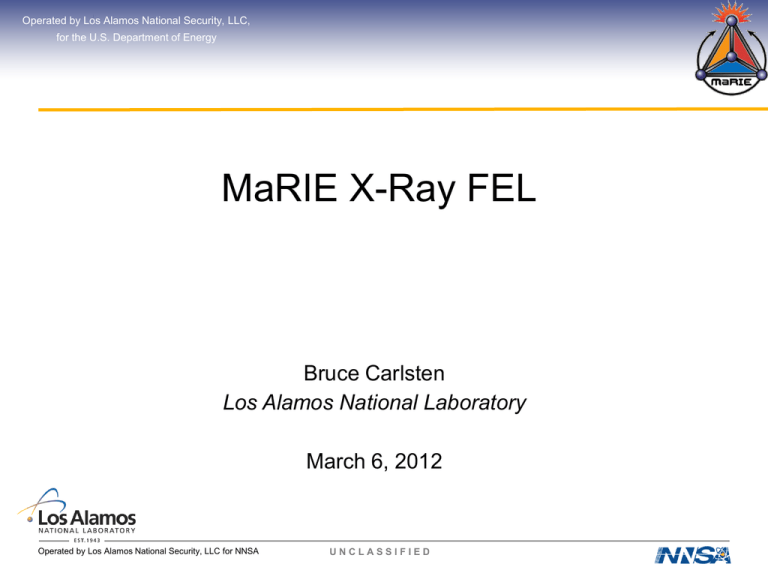
Operated by Los Alamos National Security, LLC, for the U.S. Department of Energy MaRIE X-Ray FEL Bruce Carlsten Los Alamos National Laboratory March 6, 2012 Operated by Los Alamos National Security, LLC for NNSA UNCLASSIFIED Overview What is MaRIE and XFEL Description • Proposal process (MaRIE 1.0) Baseline Design Concept Advanced Design Concepts • Emittance partitioning example (Thursday: Bishofberger) • Beam-based seeding (Thursday: Bishofberger, Marksteiner, Yampolsky) Acknowledgements: Rich Sheffield, Pat Colestock, Kip Bishofberger, Leanne Duffy, Cliff Fortgang, Henry Freund, Quinn Marksteiner, Steve Russell, Rob Ryne, Pete Walstrom, Nikolai Yampolsky Slide 2 Operated by Los Alamos National Security, LLC for NNSA UNCLASSIFIED MaRIE and the proposal process The Laboratory has defined a signature science facility MatterRadiation Interactions in Extremes (MaRIE) ~ $2B for full capabilities NNSA asked the Laboratory to respond (2/15/12) to their call with a trimmed-down facility (MaRIE 1.0) ($B class proposal) • LANL, LLNL, SNL each responded to NNSA call with multiple proposals – NNSA will develop a future science roadmap based on input from this call • NNSA may provide a MaRIE ~CD0 sometime in FY13; LANL has internal funds for beginning enabling R&D in FY12 • Work that is presented at this workshop is largely funded by a Los Alamos LDRD project to identify advanced design options 12-GeV electron linac driving 42-keV (0.3Å) XFEL is cornerstone of MaRIE 1.0 Slide 3 Operated by Los Alamos National Security, LLC for NNSA UNCLASSIFIED MaRIE builds on the LANSCE facility to provide unique experimental tools to meet future materials science needs First x-ray scattering capability at high energy and high repetition frequency with simultaneous charged particle dynamic imaging (MPDH: Multi-Probe Diagnostic Hall) Unique in-situ diagnostics and irradiation environments beyond best planned facilities (F3: Fission and Fusion Materials Facility) Comprehensive, integrated resource for materials synthesis and control, with national security infrastructure (M4: Making, Measuring & Modeling Materials Facility) • Accelerator Systems Electron Linac w/XFEL LANSCE proton accelerator power upgrade • Experimental Facilities • Conventional Facilities MaRIE will provide unprecedented international user resources Slide 4 Operated by Los Alamos National Security, LLC for NNSA UNCLASSIFIED Why 42-keV XFEL? MaRIE seeks to probe inside multigranular samples of condensed matter that represent bulk performance properties with subgranular resolution. With grain sizes of tens of microns, "multigranular" means 10 or more grains, and hence samples of few hundred microns to a millimeter in thickness. For mediumZ elements, this requires photon energy of 50 keV or above. This high energy also serves to reduce the absorbed energy per atom per photon in the probing, and allows multiple measurements on the same sample. Interest in studying transient phenomena implies very bright sources, such as an XFEL. Slide 5 Operated by Los Alamos National Security, LLC for NNSA UNCLASSIFIED MaRIE photon needs can be met by an XFEL (and 1010 photons and 10-3 bandwidth for MaRIE 1.0 XFEL) MPDH FFF M4 Energy/Range (keV) 50 <10 - >50 10-400 0.1-1.5 10-50 Photons per image 1011 1011 109 109 1011 Time scale for single image 50 fs >1 s 0.001 s 10-500 fs 50 fs Energy Bandwidth (∆E/E) 10-4 10-4 10-3 10-4 10-4 Beam divergence 1 mrad 1 mrad < 10 mrad < 10 mrad 1 mrad Trans. coherence (TC) or spatial res. TC TC 1-100 mm TC TC Single pulse # of images/duration 100/1.5 ms - - - - Multiple pulse rep. rate/duration 120 Hz/day 0.01 Hz/mo. 60 Hz/secs 1 KHz/day 10 Hz/days Longitudinal coherence yes yes no yes yes Polarization linear linear no Linear/circular linear Tunability in energy (∆E/E/time) 2%/pulse fixed fixed 10%/s 10x/day Photon energy - set by gr/cm2 of sample and atomic number Photon number for an image - typically set by signal to noise in detector and size of detector Time scale for an image - fundamentally breaks down to transient phenomena, less than ps, and semi-steady state phenomena, seconds to months Bandwidth - set by resolution requirements in diffraction and/or imaging Beam divergence - set by photon number loss due to stand-off of source/detector or resolution loss in diffraction Source transverse size/transverse coherence - the source spot size will set the transverse spatial resolution, if transversely coherent then this limitation is not applicable so transverse coherence can be traded off with source spot size and photon number Number of images/rep rate/duration – images needed for single shot experiments/image rep rate/ duration of experiment on sample Repetition rate - how often full images are required Longitudinal coherence – 3D imaging Polarization - required for some measurements Tunability – time required to change the photon energy a fixed percentage Slide 6 Operated by Los Alamos National Security, LLC for NNSA UNCLASSIFIED MaRIE 1.0 XFEL requires tiny emittances Emitance is constrained both by beam energy and transverse coherency: beam g lab x ray 4 wiggler 8g 2 K 2 1 ˆ 2 n / g X ray The choice for beam energy (g) is dominated by the beam emittance, not wiggler period (which can go down to 1 cm) Energy diffusion limits how high the beam energy can be (~ 20 GeV), puts a very extreme condition on the beam emittance (ideally ~ 0.1 mm at 12 GeV) d dz E QF 2 4 An emittance of 0.1 mm is an emittance ratio of about 1 for the figure above (at 12 GeV). MaRIE 1.0 XFEL baseline emittance (0.2 mm) leads to a transverse coherency of about 0.8. 55 e g re B w 2 3 24 3 m e c Slide 7 Operated by Los Alamos National Security, LLC for NNSA UNCLASSIFIED The baseline MaRIE 1.0 XFEL is an aggressive extrapolation of LCLS parameters – the bolded parameters are advanced targets Wavelength Beam energy Bunch charge Pulse length (FWHM) Peak current Normalized rms emittance Energy spread Undulator period Peak magnetic field Undulator parameter, aw Gain length, 1D (3D) Saturation length Peak power at fundamental Pulse energy # of photons at fundamental UNIT Å GeV pC fs kA mm-mrad % cm T m m GW mJ LCLS 1.5 14.35 250* 80* 3.0* 0.3-0.4 0.01 3 1.25 2.48 (3.3)* 65 30* 2.5* 2 x 1012* MARIE 1.0 baseline 0.293 12.0 100 (250) 30 (75) 3.4 0.2 (0.1) 0.01 1.86 0.70 0.86 (6.0) 80 8 (17.6) 0.24 (2.4) 2x1010 (2x1011) *Y. Ding, HBEB, 11/09 Slide 8 Operated by Los Alamos National Security, LLC for NNSA UNCLASSIFIED Idealized time-dependent GENESIS simulations motivate baseline design (0.01% energy spread) ELEGANT simulations indicate that 0.2 micron emittance, 0.01% energy spread reasonable starting points Consistent with new injector simulations at low bunch charges (100 pC) Slide 9 Operated by Los Alamos National Security, LLC for NNSA UNCLASSIFIED MaRIE XFEL baseline and advanced conceptual thinking L-band photoinjector S-band accelerator to 250 MeV First bunch compressor S-band accelerator to 1 GeV MaRIE XFEL baseline should be fully upward compatible with advanced design technology insertions: • Emittance partitioning at 250 MeV • Initial modulation at 200 nm before second bunch compressor leads to harmonic current at 0.3 Å • Single-bunch seeding may be better alternative Second bunch compressor S-band accelerator to 12 GeV XFEL undulator - resonant at 0.3 Å Injector bunch length and first compressor energy main trades 10-40 psec to 3 psec (at ~250 MeV) to 30 fsec (at 1 Gev to maintain upward compatibility) Slide 10 Operated by Los Alamos National Security, LLC for NNSA UNCLASSIFIED Novel photoinjector design (Rich Sheffield) may directly lead to emittances of 0.1 micron for 100 pC (with thermal component) Complex tailoring of longitudinal bunch profile leads to more uniform fields, less wavebreaking and significantly better emittance compensation Moving from PARMELA (red) to OPAL (blue) simulations for higher fidelity Motivated by PITZ photoinjector scaling: n 0 . 7 ( m m) q (nC) Slide 11 Operated by Los Alamos National Security, LLC for NNSA UNCLASSIFIED 2nd BC at 1 GeV: ELEGANT simulations assume 0.15 micron initial emittance and 500 eV initial beam energy (at 30 psec) (double EEX design motivated by Zholents) Octupole Dipoles 70:1 Telescope Sextupole and lens RF cavity Initial: x= 0.15 mm sx= 386 mm z= 92.6 mm sz= 400 mm (3-psec FWHM) Final longitudinal phase space (12 GeV) Octupole is able to straighten longitudinal phase space After 1st EEX: x= 92.7 mm sx= 5060 mm z= 0.169 mm sz= 25.2 mm After octupole: x= 47.8 mm sx= 5060 mm z= 0.155 mm sz= 25.2 mm Before 2nd EEX: x= 47.8 mm sx= 75 mm After 2nd EEX: z= 0.155 mm sz= 25.2 mm x= 0.170 mm sx= 318 mm z= 47.8 mm sz= 4.33 mm (30 fsec FWHM) Slide 12 Operated by Los Alamos National Security, LLC for NNSA UNCLASSIFIED Baseline coupled time-dependent ELEGANT/GENESIS simulations Some degradation from idealized results due to non-ideal bunch shape Still, results indicate a nominal 2 1010 X-rays from 60-m undulator, bandwidth ~ 10-3, relatively conservative initial emittance and energy spreads (500 eV is about factor of 2 larger than our PARMELA simulation results, leads to final energy spread of ~ 5 10-5) Likely significant increase (factor of 2) with additional tuning, added safety factor Beam transport reasonable Slide 13 Operated by Los Alamos National Security, LLC for NNSA UNCLASSIFIED Nonlinear undulator taper research is important to both MaRIE 1.0 baseline and advanced concepts Nonlinear taper (10-14%) increases power by factor of ~ 40 (time-independent simulations) GENESIS Want the MaRIE 1.0 design to be upwardly compatible with 200m undulator with a quadratic taper Evolution of the Energy Distribution MEDUSA Slide 14 Operated by Los Alamos National Security, LLC for NNSA UNCLASSIFIED Emittance partitioning at 250 MeV 75% scraping e <N = g b 2 +d 2 d int ind e 2 + e x2,int x ,ind d slew x = 4.9 mm 10-6 6 10-5 Chicane-based compressor to 3 psec e >N = g bd slews z 250 pC x = 0.1 mm y = 0.1 mm “slice” z < 0.9 mm by 50 keV = 90 mm Slide 15 Operated by Los Alamos National Security, LLC for NNSA UNCLASSIFIED
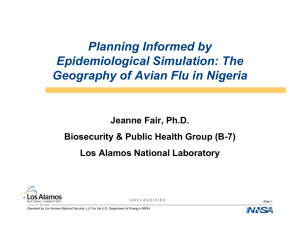
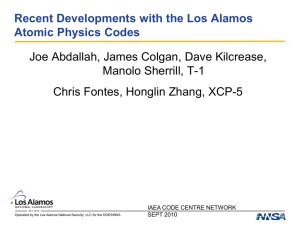
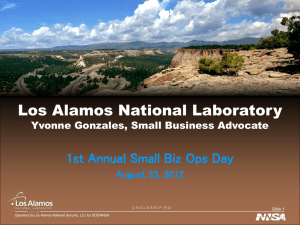
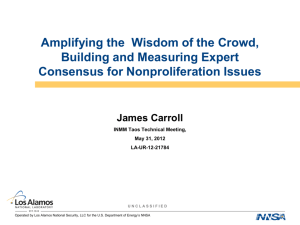
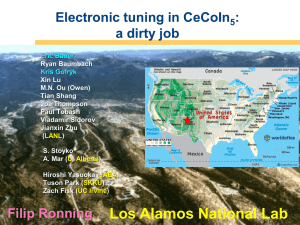
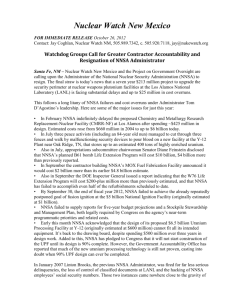
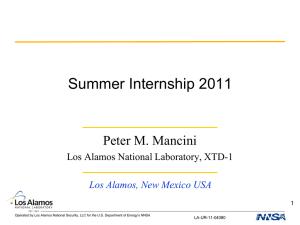
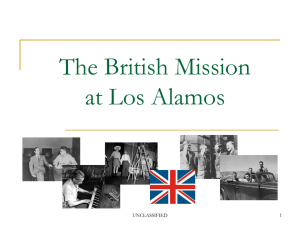
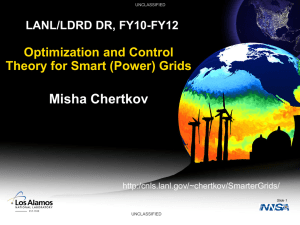

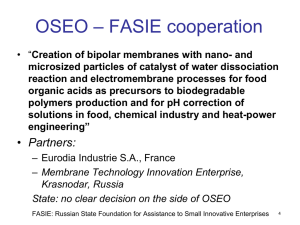
![Your_Solutions_LLC_-_New_Business3[1]](http://s2.studylib.net/store/data/005544494_1-444a738d95c4d66d28ef7ef4e25c86f0-300x300.png)